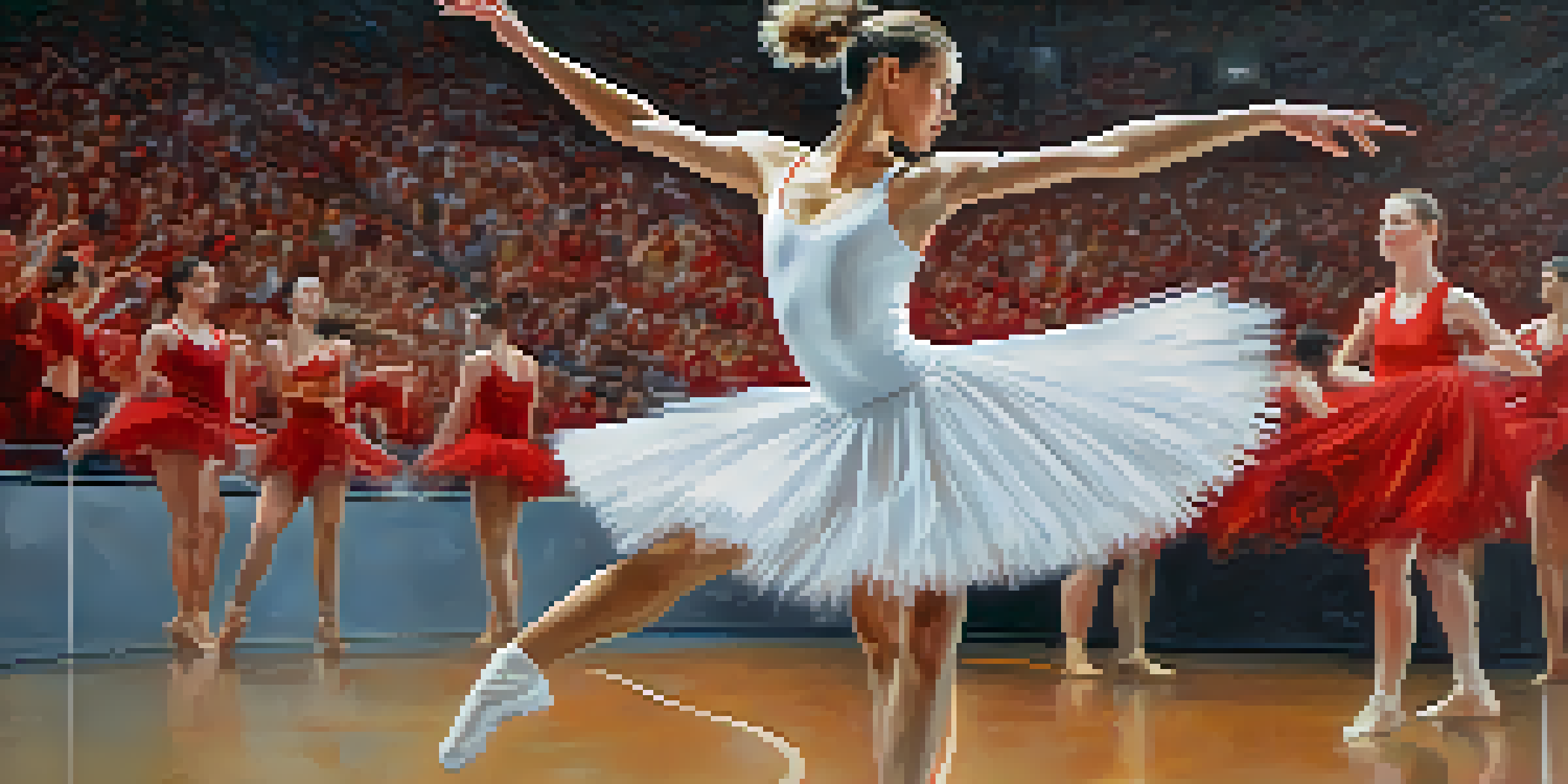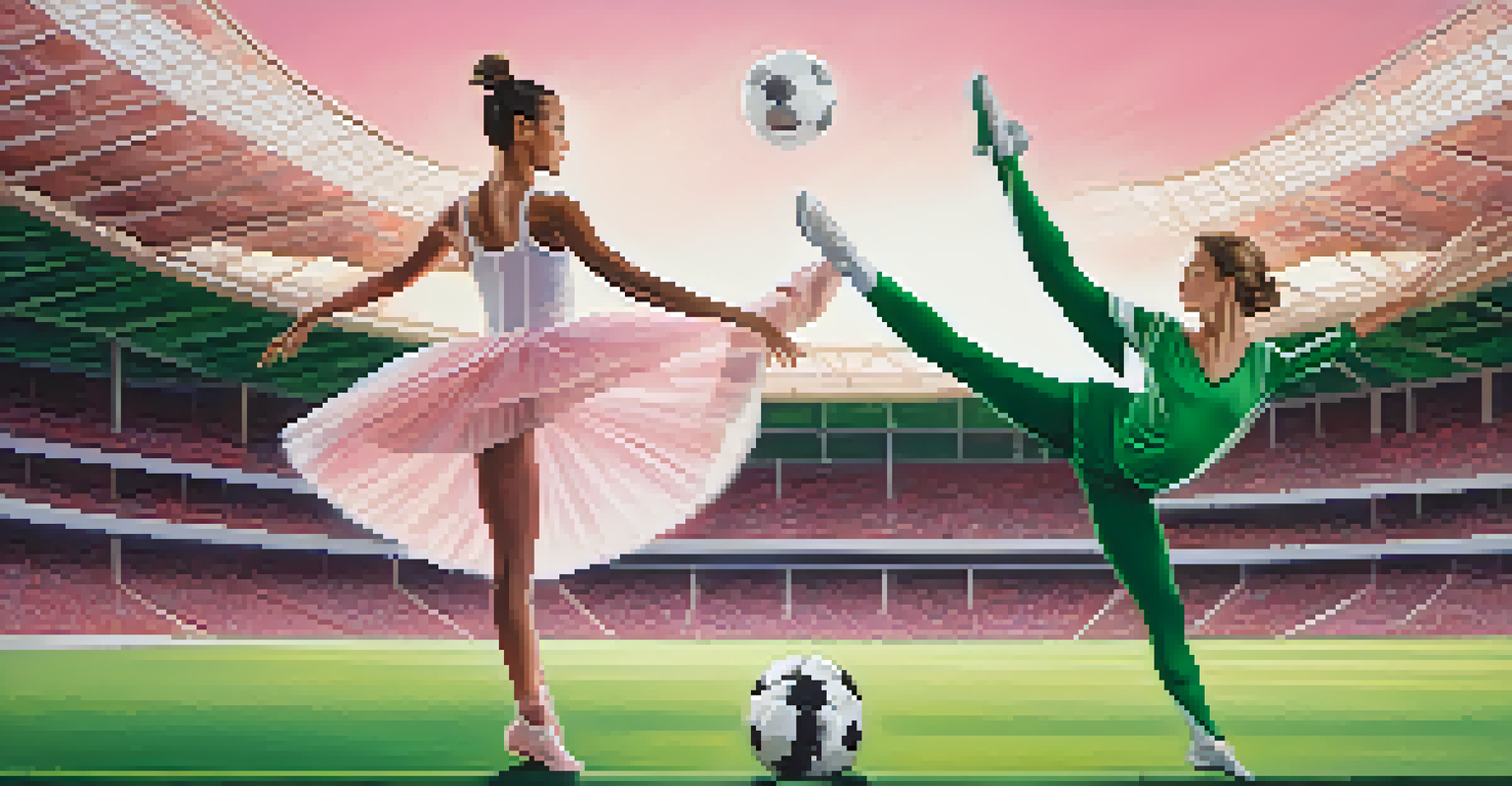The Art of Movement: Dance and Sports Synergy Explained

Understanding the Connection Between Dance and Sports
Dance and sports, while seemingly different, share a profound connection rooted in movement. Both disciplines emphasize body control, rhythm, and coordination, making them more alike than many realize. For instance, a dancer's ability to execute precise movements mirrors an athlete's need for agility on the field.
Dance is the hidden language of the soul.
This synergy is not just about physicality; it's also about creativity and expression. In dance, athletes learn to express emotions through movement, enhancing their overall performance. Similarly, dancers can benefit from the competitive spirit found in sports, pushing their limits and honing their skills.
By recognizing these parallels, we can appreciate how integrating aspects from both dance and sports can lead to improved performance and a deeper understanding of movement. It's a dance-off on the field and a sports showdown on the stage, and both have valuable lessons to teach.
The Role of Rhythm in Enhancing Performance
Rhythm is the heartbeat of both dance and sports, guiding movements and creating flow. In dance, rhythm dictates timing, while in sports, it helps athletes synchronize their actions with the game’s pace. For instance, a basketball player dribbling to the beat of music can improve their coordination and timing on the court.

Engaging with rhythm can also enhance focus, allowing athletes and dancers to enter a state of 'flow' where performance feels effortless. This heightened sense of awareness can lead to improved execution and reduced errors. Dancers often use musicality to enhance their emotional expression, while athletes can use it to enhance their strategic plays.
Dance and Sports Share Core Skills
Both dance and sports emphasize movement, coordination, and creativity, highlighting their interconnectedness.
Incorporating rhythmic training can be beneficial for both groups, as it fosters a deeper connection to movement. Whether it's through clapping, drumming, or moving to music, rhythm serves as a universal language that enhances performance in both sports and dance.
Flexibility: A Key Component of Both Disciplines
Flexibility is often touted as a primary benefit of dance, but it's equally crucial in sports. Athletes who maintain a high level of flexibility can reduce their risk of injury and improve their range of motion. Dancers, on the other hand, rely on flexibility to achieve stunning visual aesthetics and execute complex movements.
The only way to prove that you are a good sport is to lose.
Consider a gymnast who combines dance-like grace with athletic prowess. Their success hinges on flexibility, allowing them not just to perform but to captivate audiences. Similarly, a football player who can stretch and twist effectively can dodge defenders, showcasing the importance of flexibility in both realms.
Integrating flexibility training from dance into sports routines can create well-rounded athletes. This crossover encourages injury prevention and enhances overall performance, proving that flexibility is a bridge connecting these two art forms.
Strength Training: The Backbone of Performance
Both dance and sports require strength, yet they approach it differently. Dancers often focus on core strength and stability, essential for balance and control during performances. Athletes, however, might emphasize explosive strength to enhance speed and power in their respective sports.
Take ballet dancers, for instance; their training involves a lot of resistance work, which builds muscle endurance and strength. On the flip side, a soccer player might engage in weight training to develop leg strength for powerful kicks. Yet, both disciplines rely on strength to execute their movements effectively.
Rhythm Boosts Performance in Both
Engaging with rhythm enhances focus and execution, allowing both dancers and athletes to achieve a state of flow.
Incorporating strength training principles from both fields can enhance athletic performance. A ballet dancer can benefit from explosive strength training, while an athlete can improve their grace and control through dance-inspired strength exercises.
The Mental Game: Focus and Mindfulness in Movement
Mental focus plays a crucial role in both dance and sports, as it allows individuals to perform at their best. Dancers must be present in the moment to execute intricate choreography, while athletes need to concentrate on strategy and execution during competition. Both require mental sharpness and clarity to achieve peak performance.
Mindfulness practices, such as meditation and visualization, are common in both fields. Dancers visualize their movements to enhance performance, while athletes can mentally rehearse plays to solidify their strategies. These techniques foster a deeper connection between body and mind, crucial for achieving excellence.
By adopting mental training techniques from dance, athletes can enhance their focus and reduce performance anxiety. Conversely, dancers can benefit from learning how to channel their competitive spirit, creating a well-rounded approach to movement.
Injury Prevention: Lessons from Dance and Sports
Injury prevention is a vital aspect of both dance and sports, as both fields involve physical exertion. Dancers often face injuries related to overuse and improper technique, while athletes worry about acute injuries during competitions. Understanding the common injuries in both areas can help in developing better prevention strategies.
For instance, dancers are trained in warm-up routines that prepare their bodies for movement, a practice athletes can adopt to enhance flexibility and reduce injury risk. Additionally, dance emphasizes the importance of body awareness, enabling performers to recognize their limits and listen to their bodies.
Flexibility and Strength are Key
Both disciplines benefit from flexibility and strength training, which improves performance and reduces injury risk.
Integrating injury prevention techniques from dance into sports training can create a safer environment for athletes. This holistic approach ensures that both dancers and athletes prioritize their well-being while pushing their boundaries.
The Future of Movement: Bridging Dance and Sports
As we continue to explore the synergy between dance and sports, new opportunities arise for collaboration and innovation. Programs that combine dance techniques with athletic training are becoming more popular, allowing participants to experience the best of both worlds. This trend not only enhances performance but also fosters a greater appreciation for movement as an art form.
Dance festivals and sports competitions are increasingly showcasing elements from each other, creating a platform for athletes and dancers to collaborate. Imagine a basketball game featuring a halftime dance performance, where dancers and athletes share the stage, celebrating their unique skills and movements.

The future of movement lies in breaking down barriers and embracing the artistry of sports and dance. This exciting evolution will inspire the next generation of performers, encouraging them to explore the limitless possibilities of movement.